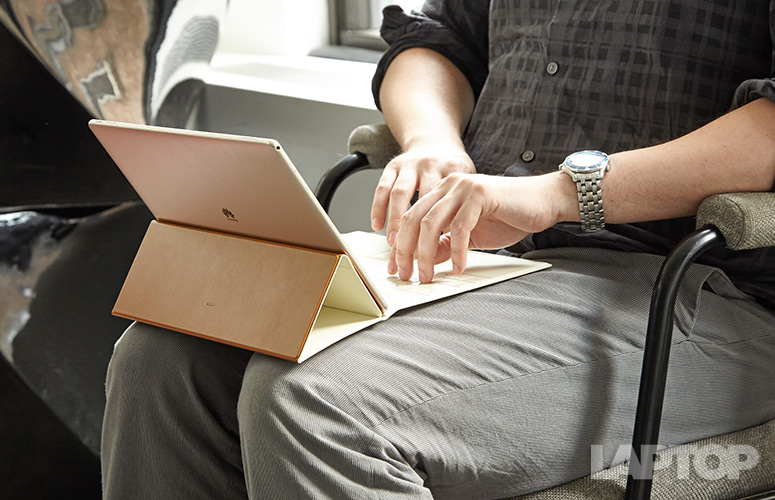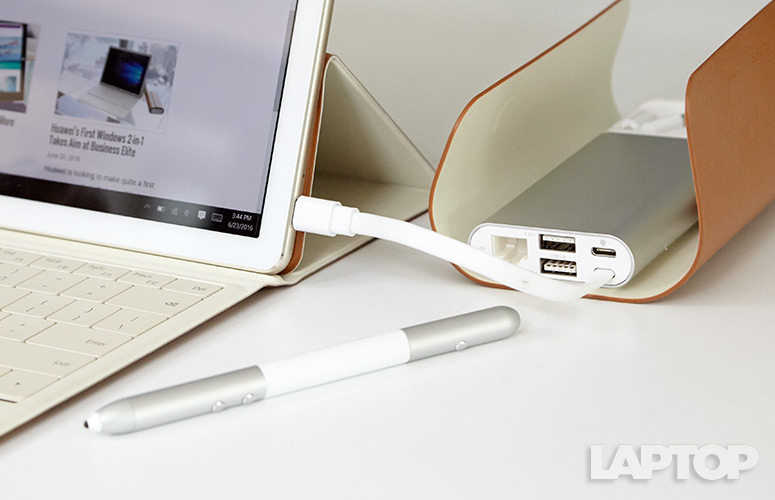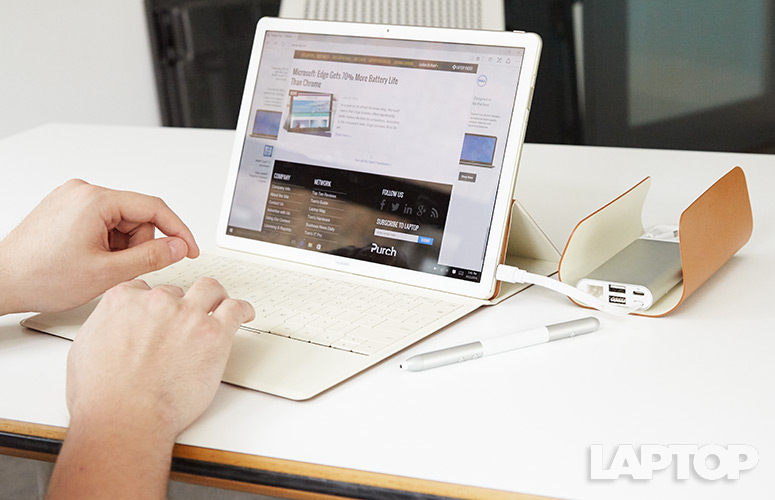Laptop Mag Verdict
Huawei's first Windows PC is a good-looking 2-in-1 with a vivid screen, but weak battery life makes this a less-than-impressive debut.
Pros
- +
Attractive, premium design
- +
Bright, vivid display
- +
Wide range of accessories
Cons
- -
Anemic battery life
- -
Slow SSD
- -
Folding keyboard isn't very sturdy or comfortable
- -
Only one USB Type-C port
Why you can trust Laptop Mag
Huawei is already the third-largest smartphone maker, trailing just Samsung and Apple, but it seems like that's not enough for the company. With the MateBook, Huawei is expanding into the world of Windows 2-in-1s with a top-notch detachable design and some luxurious leather-bound accessories. Starting at $699 (without a keyboard), the 12-inch MateBook looks to steal some glory from systems such as the Samsung TabPro S and even the Microsoft Surface Pro 4. However, its anemic battery life, slow storage speed and so-so keyboard prevent it from overtaking or even matching its competitors.
Design
With an aluminum body featuring seductive, chamfered edges and a display with an impressively small bezel, the MateBook has a premium design on a par with other flagship detachables and nearly identical to Samsung's TabPro S. There's a power button on the top right, a magnetic Pogo pin connector on the bottom for attaching a keyboard and a whole lot of seductive brushed aluminum on its back. However, I wish there were a little less flex to the body.
When you add on its $129 folding keyboard, the MateBook transforms from a simple 2-in-1 into a true premium laptop. Its genuine leather backing is a pleasure to touch and looks just right when it's set next to an expensive purse or briefcase.
Measuring 10.9 x 7.64 x 0.27 inches and weighing 1.41 pounds sans keyboard, the MateBook is barely lighter than the Samsung TabPro S (11.43 x 7.83 x 0.25 inches and 1.5 pounds). With the keyboard, the 0.48-inch MateBook is slightly thinner than the 0.57-inch TabPro S, although it's not enough of a difference to stop anyone from picking one over the other.
Ports
One port on a 2-in-1 simply isn't enough, especially when the MateBook's lone USB 3.1 Type-C port is responsible for charging, data transfer and video output.
Sign up to receive The Snapshot, a free special dispatch from Laptop Mag, in your inbox.
At least the Microsoft Surface Pro 4 has a separate connector for power. Huawei deserves props for providing a micro-USB-C-to-USB-Type-A adapter and a USB-C-to-micro-USB adapter in the box, which helps prevent some of the headache for those making the switch to USB Type-C.
But free adapters still don't give you a way to plug in a mouse while you recharge your computer. For that, you'll have to shell out an additional $89 for the MateDock, which includes ports for Ethernet, USB Type-C, two USB Type-A, HDMI and VGA.
Keyboard and Touchpad
The MateBook's keyboard had fairly average key travel of 1.6 millimeters and required a reasonable 52 grams of actuation weight to press them. However, the MateBook's folding keyboard suffers from a cramped design and lifeless key action that make it less than a pleasure to use. Instead of a traditional Chiclet-style layout, the MateBook's keyboard has almost no space between the keys. Microsoft moved away from this design more than six months ago with its Type Cover 4, and Huawei really should have taken that lesson to heart.
I struggled on 10fastfingers.com's typing test, where I managed just 67 words per minute with five typos -- far from my typical 75- to 80-wpm pace.
The MateBook's folding keyboard suffers from a cramped design and lifeless key action.
According to Huawei, the keyboard can be used in two positions, although the more angled of the two isn't very sturdy because it depends on magnets to hold the folding keyboard's flappy kickstand in place. This causes the MateBook to fall down if you so much as give it a mean look, and while the more upright position is significantly more stable, it's still no good for use in your lap.
The folding cover's 3.7 x 2.3-inch touchpad was much less offensive, and despite the touchpad's somewhat numb response to left and right clicks, I never really ran into issues while mousing around or using multitouch gestures such as pinch to zoom.
Display
My favorite part about the MateBook is its display. Even though its 12-inch, 2160 x 1440 screen is a regular old IPS LCD panel, it's superbright and has the deep, vivid colors of an AMOLED display. That made the trailer for Independence Day: Resurgence sparkle with bolts of neon green and plenty of deep-orange flames as aliens made their apocalyptic return to Earth.
The downside is that the display skews toward the cool side, which gives everything a bit of a blue cast. That effect was especially noticeable in images with white backgrounds. Thankfully, there's a color-temperature setting that lets you adjust the white balance.
Featuring a strong screen brightness of 367 nits, the MateBook is brighter than the Samsung Galaxy TabPro S (341 nits) and the HP Spectre x2 (322 nits). Only the Surface Pro 4 (382 nits) shines brighter in this class.
MORE: Best 2-in-1s (Laptop/Tablet Hybrids)
With a color range that covers 145.3 percent of the sRGB spectrum, the MateBook demonstrated an ability to produce a wide range of hues and shades. While Samsung's TabPro S can output even more color, at 180.2 percent, the Surface Pro 4 displayed a more limited, though still excellent, 100 percent, while HP's Spectre x2 disappointed, with a range of 71.9 percent.
I like Huawei's fingerprint sensor on the side of the system, which works brilliantly with Microsoft's Windows Hello biometric login system.
Finally, with a Delta-E of 2.5, the MateBook's color accuracy was good, but not great (0 is best). The Surface Pro 4 was nearly perfect, with a Delta-E of 0.35, and the Spectre's Delta-E of 0.71 was quite good, too. The TabPro S' mark of 4.7 was even worse than the MateBook's.
Audio
The MateBook's stereo speakers had middling output in our tests. The system's lack of bass is forgivable, as that's a trait shared by almost every other detachable. But it also sometimes sounded a bit flat and shallow, especially when playing mids and highs. When I listened to Fred Falke's "It's a Memory," the song's bubbly vocals and effervescent synths didn't have the same level of depths and richness as I heard on other detachables.
Heat
When you really push it, the MateBook can get pretty hot, with temperatures on its back reaching 105 degrees Fahrenheit or higher. But if you're just working on some office docs or streaming a video or two, the MateBook stays much cooler to the touch. When I checked its temperature after streaming HD video from Hulu for 15 minutes, the hottest spot on the system (the Huawei logo on the front) measured 97 degrees, which is slightly above our 95-degree comfort threshold.
Fingerprint Reader
I like Huawei's inclusion of a fingerprint sensor on the side of the system.
This is one of the first 2-in-1s to do so, and it works brilliantly with Microsoft's Windows Hello biometric login system. It's a nice touch and something that I'd like to see become a standard feature on 2-in-1s.
Performance and Graphics
Even though it doesn't come with a powerful Core i CPU like you get on a Surface Pro, the MateBook's Core m5 processor had good enough performance for everyday tasks. I didn't encounter any lag during my time with the MateBook, which included a few sessions of multitasking while streaming HD music from YouTube with multiple benchmarks running and 15 browser tabs open in the background.
On Geekbench 3, which tests a system's overall performance, our review unit (featuring a Core m5 CPU, 8GB of RAM and a 256GB SSD) scored 5,739. That's right in line with other Core m-powered detachables. As expected, the m7-powered HP Spectre x2 was a bit faster, with a score of 5,814, while the less robust Core m3-equipped Samsung TabPro S finished a bit behind, with a score of 4,675. However, a Core i5-equipped Surface Pro 4's score of 6,811 showed which detachable is the real performance king.
I saw similar results when we used OpenOffice to match 20,000 names with their addresses in OpenOffice Calc. The MateBook's time of 4:55 was faster than the Tab Pro S (5:45) and the Spectre x2 (5:34), but slower than the Surface Pro 4 (4:11).
MORE: 10 Tablets with the Longest Battery Life
The MateBook's slow-moving SSD holds it back in a big way. The MateBook took 1 minute and 18 seconds to copy 4.97GB of mixed media files, for a transfer rate of just 64.46 MBps. That's half the speed of similar systems, including the TabPro S (117 MBps) and the Spectre x2 (149 MBps), and more than four times slower than the Surface Pro 4 (382 MBps).
With a score of 482 in 3DMark's Fire Strike benchmark, the MateBook showed off graphics performance that was at about the same level as other Core m detachables. This means you'll be fine playing casual 2D titles or older games like Bastion, but anything more demanding than that is pretty much a no-go.
Battery Life
Over the past six months, most Windows detachable 2-in-1s have demonstrated poor battery life, so I wasn't expecting a long runtime for the MateBook. But what Huawei delivered was appalling.
On the Laptop Mag Battery Test, the MateBook lasted a truly disappointing 3 hours and 54 minutes.
On the Laptop Mag Battery Test (continuous web surfing over Wi-Fi at 100 nits), the MateBook lasted a truly disappointing 3 hours and 54 minutes.
MORE: Laptops with the Longest Battery Life
That's 4 hours less than an average ultraportable and 2 hours less than the recent batch of 2-in-1s we've tested. HP's Spectre x2, Samsung's Galaxy TabPro S and Microsoft's Surface Pro 4 all lasted significantly longer at 6:46, 6:31 and 6:05, respectively.
Cameras
Unlike the soft and grainy image quality you get on other hybrid webcams, images from the MateBook's 5-megapixel front camera are surprisingly sharp. Its pictures look more like what you'd get on a smartphone -- that's pretty impressive, and it makes a lot of sense, considering Huawei's extensive smartphone portfolio.
When I used the MateBook's front camera to shoot a quick selfie in our office, I saw crisp focus and sharp details throughout the entire photo. The only minor downside was some shutter lag that occurred when I took a series of pics.
Configurations
The MateBook starts at $699 for an Intel Core m3 CPU, 4GB of RAM and a 128GB SSD, if all you want is the tablet. The folding keyboard costs an extra $129 and is available in black, brown, orange or beige leather, as is the $89 MateDock. And if you want something to sketch with, the MatePen will run you an extra $59.
If you want a faster machine, you can opt for higher-spec versions like our $999 review unit, which features a Core m5 CPU, 8GB of RAM and a 256GB SSD, or tack on an ever larger 512GB SSD for a total of $1,199.
Software and Warranty
One of the best things about the MateBook is its Windows Signature Edition setup. That means there are no preinstalled trials, links to online retailers or bloat of any kind. The one tiny addition to the OS is Huawei's MateBook Assistant, which serves as a product manual, driver updater and help center rolled into one. The MateBook also comes with a standard one-year warranty.
Bottom Line
When it came to delivering a premium-feeling 2-in-1, Huawei absolutely nailed it with the MateBook. Its metal chassis feels strong and luxurious at the same time, and its 12-inch display is a joyous sight to behold.
The problem is that the beauty is only skin-deep. This system's storage speeds are pretty underwhelming, you get only one port and its battery lasts nearly 2 hours less than those of all of its competitors.
As Huawei's first Windows 2-in-1, the MateBook's design shows a lot of promise. But with such bad battery life and performance, the company's first venture into convertible PCs is a pass. You'd be better off with the pricier Microsoft Surface Pro 4 or the more affordable HP Spectre x2.
Huawei MateBook Specs
| Bluetooth | Bluetooth 4.1 |
| Brand | Huawei |
| CPU | 1.1-GHz Intel Core m5-6Y54 CPU |
| Company Website | www.gethuawei.com |
| Display Size | 12 |
| GPS | Yes |
| Graphics Card | Intel HD Graphics 515 |
| Hard Drive Size | 256GB |
| Hard Drive Speed | n/a |
| Hard Drive Type | SSD |
| Native Resolution | 2160 x 1440 |
| Operating System | Windows 10 Home |
| Ports (excluding USB) | Combo Headphone/Mic Jack, USB 3.1 with Type-C |
| RAM | 8GB |
| Size | 10.9 x 7.64 x 3.99 x 0.27 |
| Touchpad Size | 3.7 x 2.3 |
| USB Ports | 1 |
| Video Memory | Shared |
| Warranty/Support | one-year |
| Weight | 1.41 pounds |
| Wi-Fi Model | 802.11 a/b/g/n/ac MIMO |
Sam Rutherford is a writer at Laptop Mag, focusing on laptop reviews and all the gadgets that make using a notebook just that much easier (or more fun). Over the years, he reviewed some iconic laptops, including gaming beasts from Alienware, Asus, Acer, Gigabyte, and HP. Outside of gaming laptops, Sam has also reviewed notebooks oriented around productivity, such as the Lenovo IdeaPad or the Dell XPS.







